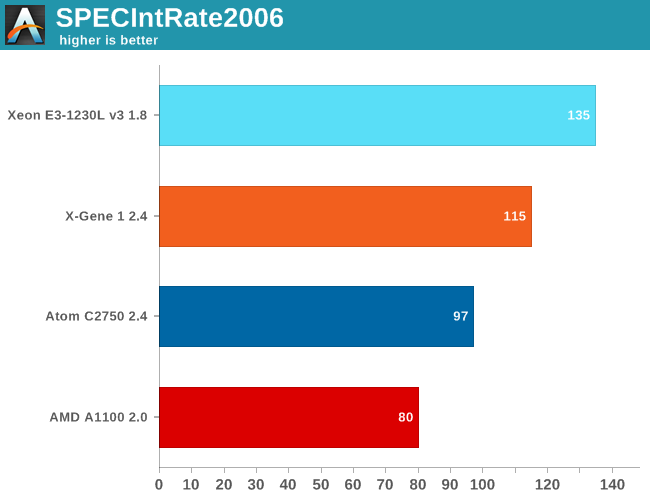ARM Challenging Intel in the Server Market: An Overview
by Johan De Gelas on December 16, 2014 10:00 AM ESTPerformance
The first SPECIntRate 2006 estimates were published by "CPU meister" Andreas Stiller. If we combine his findings with what we know and what is available at SPEC.org, we get the benchmark graph below.

Intel's own published SPECintrate scores are up to 20% higher, so at first sight the ARM competition is not there yet. However, we prefer to show the "lower numbers" as they have not been benchmarked with masterfully set ICC configuration settings.
The most aggressive architecture, the X-Gene, is quite a bit slower than the Xeon E3-1230L. The latter needs about 40W per node (SoC + chipset), while an X-Gene node would need almost 60W. AppliedMicro really needs the 28nm 2.8GHz X-Gene 2, which apparently can offer a 50% better performance per watt increase in SPECintrate 2006.
However, we have shown you that while SPECintrate 2006 is the standard often used, popular with most CPU designers, analysts and academic researchers, it is a pretty bad predictor of server performance. We should not discount the chances of the server ARM SoCs too quickly. A mediocre SPECint SoC can still perform well in server applications.










78 Comments
View All Comments
aryonoco - Wednesday, December 17, 2014 - link
I just wanted to thank you Johan De Gelas for this very insightful and interesting article.Hugely enjoyed reading it and your thoughts on the subject.
Good to see high quality content continue to be published at AT now that Anand has left.
JohanAnandtech - Wednesday, December 17, 2014 - link
aryonoco, Jann Thanks for letting me know. A good motivation to always push a bit harder to make sure I don't let my readers down :-).jann5s - Wednesday, December 17, 2014 - link
Thank you Johan, for writing this very interesting article!przemo_li - Wednesday, December 17, 2014 - link
Very well written walk through current and possible CPU/SOC parts.Will there be similar piece for software?
ARM (embedded) folks aren't famous for quality drivers/code.
It must change, so it will change. But for now such overview would be great!
bobbozzo - Wednesday, December 17, 2014 - link
Typo on page2:"(4 Slots x 8 DIMMs)" - change 8 to 8GB
Thanks
bobbozzo - Wednesday, December 17, 2014 - link
and page 4:"you will be able to choose between SoCs that have 100 Gbit Ethernet and 10GBit Ethernet."
should 100 be 40?
bobbozzo - Wednesday, December 17, 2014 - link
Page 12:"Most of them are the usual IPSec, TPC offloading engines"
Should that be TCP?
Also, are there still accelerators for AntiVirus engines and IDS/IPS search (there were some back in 2005).
Thanks
bobbozzo - Wednesday, December 17, 2014 - link
...I guess that's what the RegEx would be useful for.
However, not all IDS/IPS / A/V patterns use RegEx, and there are other means of acceleration.
eanazag - Wednesday, December 17, 2014 - link
Welcome back Johan.Glad to see you're still writing here. Good stuff in the article.
JKflipflop98 - Wednesday, December 17, 2014 - link
I simply don't get where this whole "microserver" thing is coming from.By the time you cluster up enough ARM processors to match the processing power of an Intel/AMD solution, you're burning just as much power and spent just as much money as you would have by using x86 in the first place. Except now you have to use some janky middleware solution because all your software is x86 and you're running on ARM cores.